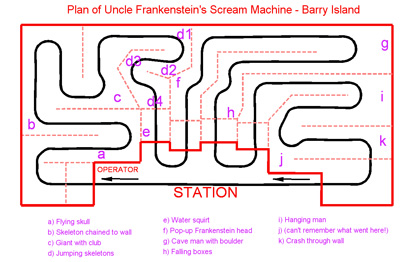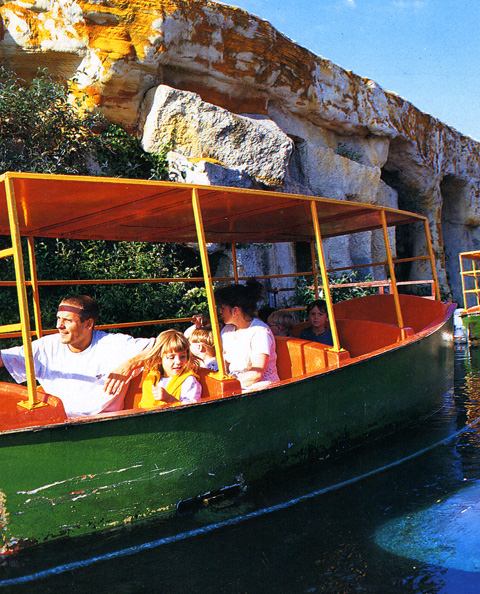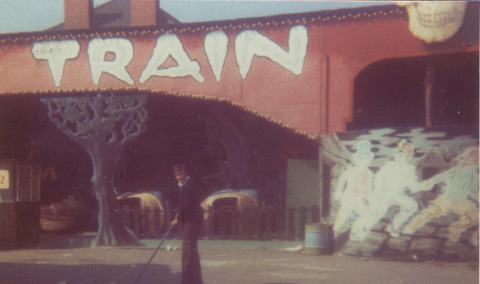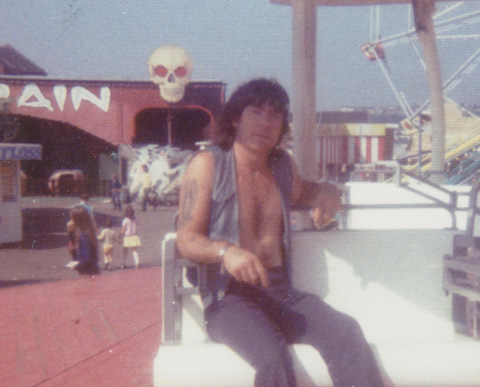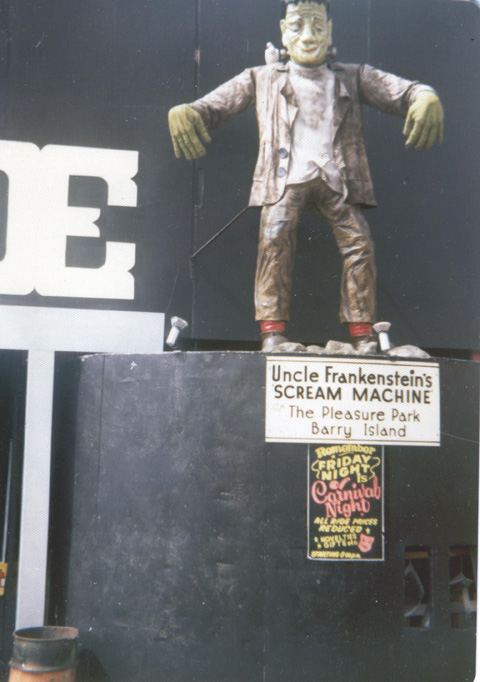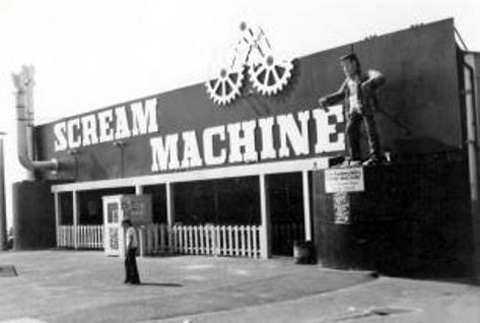|
|
|
| HOME ARTICLES GALLERIES ABOUT US FORUM LINKS CONTACT JOYLAND BOOKS | |
|
From Bond to Barry: CREATING
Uncle Frankenstein's Scream Machine by John Wardley Article: March 2013 |
|
|
Like it or not, in 1973 the owners of Barry Island Pleasure
Park, brothers John and Pat Collins, decided that the huge
wooden scenic railway was to be demolished. It had occupied a
very large proportion of the total area of the park since its
opening in 1940, and as a consequence, after its removal a
gigantic hole was left in the park’s entertainment offering. The
scenic railway had been a big money-earner, but the land it
freed-up could potentially earn far more with other new
attractions.
|
|
|
Collins Brothers turned to Alan Hawes for their
first major project...the Jungle Boat Ride. Alan
had been president of Universal Design in the
States, and had built monorails, sky towers and dark
rides all over the U.S.A. during the 1960s. But in
the early ‘70s he returned to his native Britain,
and teamed up with Ivan Bennett from Long Eaton who
was producing travelling rides for showmen. It was
Ivan who introduced Alan to John and Pat Collins and
subsequently the Jungle Boat Ride was developed at
the lower end of the old scenic railway site. The
upper end became the site of the SDC Galaxi roller
coaster, and the middle portion became the location
of a large children’s dark ride 'The Magic Island',
using Modern Products 'Alice in Wonderland' cars and
track, and nursery-rhyme scenes created by the
park’s very talented resident artist, Norman Pratt.
That still left space for a number of other
attractions including a Haunted Castle, Crazy
Cottage, various kiddie rides and side stalls.
The South Wales climate didn’t lend itself to the growth of lush tropical jungle foliage, and the animation mechanisms of the fibreglass animals soon rusted-up and became moribund. John and Pat needed to inject some instant life and atmosphere into this expensive new investment, and this is where I came in. It was July 1974. I was working on the filming of the last few special effects shots of the James Bond film 'The Man with Golden Gun' at Pinewood Studios. Whilst working in the film special effects industry I also produced a number of standard products which were used by showmen, two of which were dummy human skeletons and gorilla costumes. John Collins had the idea of dressing someone up in a gorilla suit and they would leap out at the passing boats near the end of the ride and give the passengers a scare. This animation method required nothing more than large quantities of beer and hotdogs to keep it running. In addition, a few skeletons draped around the rather sparse foliage might add to the atmosphere. So he ordered a gorilla suit and six skeletons which he would collect from me (according to my diary) on 17th August. It turned out that on that particular day I was due to work on the set at Pinewood in the afternoon. John Collins arrived to collect his skeletons in the morning and asked what I did (apart from making skeletons and gorilla costumes!). I explained that I worked in film special effects and was due to be at Pinewood later that day. He expressed interest, so I said he could come with me and watch the action. I smuggled him onto the set and he witnessed some Bond filming taking place. From then on we became the best of friends (and he was the best man at my wedding many years later). A few days later he phoned me up and asked if I would be interested in completely refurbishing an old Supercar double-decker ghost train at Barry Island. I said yes, and several weeks later (after the filming of 'The Man with the Golden Gun' had ended) I went down to Barry to have a look around. I had always wanted to create a fast and furious 'Larf in the Dark' ghost train. As the years had gone by, many operators had removed the effects from their dark rides because of vandalism. Riders tended to vandalise ghost train effects because the cars were slow (hence the riders could easily jump out, or lean out, and smash up the effects), and the rides were boring and amateurish, which left the riders in a frame of mind to abuse them. I was convinced that if the ride were fast, disorientating, and packed full of well-made robust and entertaining effects, it would not get vandalised. But I needed someone with the vision to help me see this through. I talked this over with John Collins, and he said it was worth a try. John was a very forward-thinking man, who, although brought up within a traditional showman’s family, was prepared to move with the times. He also had tremendous generosity of spirit, a kind nature, and a great sense of fun. The first thing I felt we had to do was to put the ride flat on one level. The slow grind of the cars up the ramps took all the pace and disorientation out of the old double-decker ride, the dip in the middle was rather tame compared to the roller coaster across the park, and the descents back to ground level were a safety nightmare. The existing building was big enough to pack a huge amount of track into it on one level, and the cars could be speeded up to belt around the circuit at high speed. One feature I also felt should be built into the ride was that it should emerge back out into the open at least once (and preferably twice) during the course of the ride. This was to provide a spectacle for the riders waiting to board (and arouse the curiosity of spectators undecided as to whether or not to ride). This had been done on ghost trains before, but I felt it important to precede each emergence with a shock effect just before the riders came into view, so that they would be reacting in a dynamic way when they were seen by the spectators. I measured the building, noted the track geometry of the old ride (in particular the radius of the bends the cars could negotiate) and set to at the drawing board to create a track layout (see the track layout plan I have recently re-drawn from memory). I made sure I allowed sufficient room for effects, and where these were within reach of the riders I determined that they should be built in such a robust way that they would be impervious to assault from riders (and some were designed in such a way that if malicious riders did try to vandalise them, it was the riders who came off worst!). The old ride building was gutted, the floor made level, and the Pleasure Park team (led by Len Smith, Len Marsh, and brothers Jack and Albert Holland) laid the new track. We tested the cars, and they went round the circuit a treat. Even when we speeded them up (and the rear wheels skidded round the bends!) it was obvious we still had a good long ride. Before the partitions were put in I designed the effects, but I’ll talk about these in more detail later. John Collins and I were convinced we should not call the ride a Ghost Train, and we needed a different image altogether. John’s brother Pat was not so sure. To him a Ghost Train was a Ghost Train, and that’s what it should be called, but he agreed that if we could come up with something better he’d go along with it. I have always tried to design my rides to have the widest appeal, and believe that although mystery, surprise and the occasional fright are perfectly acceptable, I am dead against sheer horror and depravity. For this reason we wanted to come up with an unusual name that would arouse curiosity in the visitors to the park, and then give the outside of the ride an appropriate façade. The name 'Scream Machine' seemed to fit the bill, and a design that gave the appearance of a gigantic mechanism with revolving cogs, reciprocating levers, and smoking chimneys seemed to appeal. But the concept was still missing something. We needed to take the aggressive edge off the ride and make it family-friendly without losing the teenage appeal and the spooky theme. So this is where I came up with the idea of Uncle Frankenstein. We would create a large animated friendly-looking monster with a smiling face and welcoming demeanour who would stand high up on the façade to draw the crowds. I commissioned Mike and Janet Blackman from Chichester to sculpt and mould the character, and a local engineering company to produce its animation mechanism. The British public were wary of traditional dark rides that had spectacular facades promising all sorts of thrills within, only to find a dark empty booth that the trains trundled round, ejecting rather bored and dissatisfied riders at the exit. In fact the German 'Geisterbahns' are mainly still like this, with incredibly elaborate and ornate facades, and virtually nothing inside. Instead, we would use the façade to draw the crowds to the ride, but let the riders be the show on the front. We would ensure that everyone that got off the ride was the greatest advocate in persuading others to ride. To ensure this was the case, considerable effort was put into conceiving the effects that assaulted you just a few seconds before you emerged from the two sets of mid-course doors and the final exit doors. Hence, the interior effects would have the lion’s share of the budget, and the façade the bare minimum. It was a risky tactic, but John and Pat had the confidence in me that I could make it work. So the façade was quite minimal, with a plain black background, huge white letters bearing the words “Scream Machine”, revolving silver cogs, metal chimneys, and, of course, the large Uncle Frankenstein figure. I composed the lyrics of a song (inspired to a large degree by the song “Monster Mash”), edited some music as a backing track and found a penniless actor at the Redgrave Theatre in Farnham to record it, and this accompanied Uncle Frankenstein’s gyrations on the front of the attraction. And at the same time, a motley team of people all over the country were creating the interior effects for us. And now I’ll let you into the secret of just what the riders of Uncle Frankenstein’s Scream Machine experienced…please refer to the layout plan as you go. |
|
|
|
|
|
THEMAGICEYE | Terms and Conditions | Privacy Policy | Contact Us |
|

